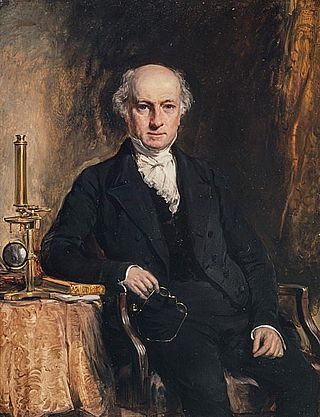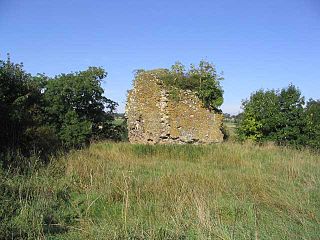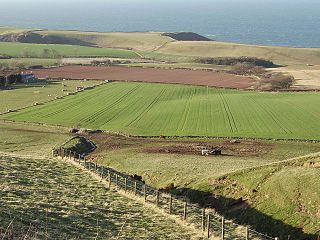Related Research Articles

Amble is a town on the North Sea coast of Northumberland, England, at the mouth of the River Coquet; Coquet Island is visible from its beaches and harbour. In 2011, it had a population of 6,025.

Thomas Caverhill Jerdon was a British physician, zoologist and botanist. He was a pioneering ornithologist who described numerous species of birds in India. Several species of plants and birds including Jerdon's baza, Jerdon's leafbird, Jerdon's bushlark, Jerdon's nightjar, Jerdon's courser, Jerdon's babbler and Jerdon's bush chat are named after him.
Berwickshire was a county constituency of the House of Commons of the Parliament of the United Kingdom from 1708 to 1918, when it was amalgamated with neighbouring Haddington(shire) to form a new Berwick and Haddington constituency.

Harold John Tennant PC, often known as Jack Tennant, was a Scottish Liberal politician. He served as Secretary for Scotland under his brother-in-law H. H. Asquith between July and December 1916.

Earlston is a civil parish and market town in the county of Berwickshire, within the Scottish Borders. It is on the River Leader in Lauderdale, Scotland.

Oldhamstocks or Aldhamstocks is a civil parish and small village in the east of East Lothian, Scotland, adjacent to the Scottish Borders and overlooking the North Sea. It is located 6 miles (10 km) south-east of Dunbar and has a population of 193. The church was consecrated by Bishop David de Bernham, 19 October 1242. Its chancel is a fine example of late Gothic — probably fifteenth-century work.

David de Bernham was Chamberlain of King Alexander II of Scotland and subsequently, Bishop of St Andrews. He was elected to the see in June 1239, and finally consecrated, after some difficulties, in January 1240. He died at Nenthorn in 1253 and was buried at Kelso. One interesting feature of his life which has left a written record is the fact that as bishop of St Andrews he consecrated a long list of churches in his diocese. These churches are listed by name, together with the dates on which they were consecrated, in the 1240s, in a 13th-century Pontifical now in the Bibliothèque National, Paris.

Whiteadder Water is a river in East Lothian and Berwickshire, Scotland. It also flows for a very short distance through Northumberland before joining the River Tweed. In common with the headwaters of the Biel Water it rises on the low hillside of Clints Dod in the Lammermuir Hills, just ESE of Whitecastle Hillfort and 3 km (1.9 mi) south-east of the village of Garvald.

George Johnston was a Scottish physician and naturalist.

Whitslaid Tower was an ancient Berwickshire seat of the Lauder family for over 300 years. It is today a ruin high above the eastern bank of the Leader Water, 2 miles (3.2 km) south of the burgh of Lauder, in the Scottish Borders. In feudal times it fell within a detached segment of the King's personal Barony of Renfrew.

The Battle of Piperdean was an engagement in the Scottish Borders, fought on 10 September 1435 between the Kingdom of Scotland and the Kingdom of England.

John Robert Lamont is a Scottish Conservative Party politician and solicitor who has served in the British House of Commons as the Member of Parliament (MP) for Berwickshire, Roxburgh and Selkirk since 2017. Lamont previously served as the Member of the Scottish Parliament (MSP) for Roxburgh and Berwickshire, later Ettrick, Roxburgh and Berwickshire after boundary changes, from 2007 to 2017. He has been serving as Parliamentary Under-Secretary of State for Scotland since October 2022.
Paxton is a small village near the B6461 and the B6460, in the pre-1975 ancient county of Berwickshire, now an administrative area of the Scottish Borders region of Scotland. It lies 1 mile west of the border with Northumberland, near Berwick-upon-Tweed. It is a traditional, country village surrounded by farmland, and its closest market towns are Duns and Berwick-upon-Tweed.

St Cuthbert's Church is located in Elsdon, Alnwick, northeast England. The church was one of the resting places of St. Cuthbert's body in the wanderings of the monks. It is one of the many dedicated to his memory. St Cuthbert's Church is a Grade I listed building in Northumberland.

Embleton Bay is a bay on the North Sea, located to the east of the village of Embleton, Northumberland, England. It lies just to the south of Newton-by-the-Sea and north of Craster. Popular for paddling, it is overlooked by the ruins of Dunstanburgh Castle and by Dunstanburgh Castle Golf Club.

The River Orchy is a river that passes through the village of Dalmally, Argyll in the West Highlands of Scotland. It rises in the Black Mount Forest, and flows southerly, passing through Loch Tulla and Glen Orchy before reaching Loch Awe. The hills of Beinn Mhic-Mhonaidh, Beinn Udlaidh and Beinn Bhreac-liath are to the north and south; there are falls and islands within the river. Reachable by the A82 road, tourists partake in kayaking, whitewater rafting, and fishing. Recent gold mining exploration has occurred in one of the river's glens just outside the Loch Lomond and The Trossachs National Park.
John Swinton (1621?–1679) was a Scottish politician active during the Wars of the Three Kingdoms and during the Interregnum. At the Restoration he was found guilty of treason and was imprisoned for some years before being released. In later life he became a Quaker.
The 1916 Berwickshire by-election was a parliamentary by-election held for the House of Commons constituency of Berwickshire in the Scottish Borders on 18 July 1916.
John Allan, was a British numismatist and scholar of Sanskrit. Allan was a noted numismatist and produced the first systematic study of the coins the Gupta Empire, which remains a standard reference today.
James Hardy LL.D. was a Scottish naturalist and antiquarian. He was secretary of the Berwickshire Naturalists' Club from 1871 until at least 1896. At least two species have been named in his honour.
References
- ↑ Jamieson, John (1841). Scottish Dictionary and Supplement: In Four Volumes. Suppl. Kab-Zic, Volume 4. Tail. p. 480.
- ↑ Hodgson, J. C. (1894). "History of the Berwickshire Naturalists' Club". 14. Berwickshire Naturalists' Club (Scotland). Amble and Hauxley: 112.
{{cite journal}}: Cite journal requires|journal=(help) - ↑ Reports from Commissioners, Great Britain. Parliament. House of Commons. House of Commons. 1861. p. 347.
- ↑ Mills, D. (1991). Ecology and Management of Atlantic Salmon. Springer. p. 108. ISBN 9780412460203.